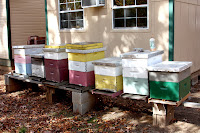Raise Bees Eat Honey!
Beekeeping is a popular hobby and, if you enjoy
using honey on your toast and in your tea, you might want to have a few hives
in the back yard.

In 2012 U.S. Apiculture, or beekeeping, produced 147
million pounds of honey but that was less than in previous years and more
beekeepers are needed. Honey has been a dietary staple for a long time. In
Spain, cave drawings dating to 6,000 B.C. show people climbing cliffs to reach
honey hives.
Local beekeepers Ruth and Lonnie O’Dell started
their beekeeping hobby in 1971 and this year their 10 hives produced around
120-pounds per hive.
“I was teaching carpentry at Indian Capital
Technology Center when I brought a swarm of bees home in a box,” said Lonnie.
“Anyone with a garden should have a hive to pollinate their vegetables and
fruit.”
The sweet rewards of beekeeping require an
investment of time and money but there are several reasons the O’Dells have
enjoyed it for so many years.
Ruth said, “Everyone who gets into it is taken by
watching the bees. They are mesmerizing.”
The O’Dells said that the basic investment in a hive
and a swarm of bees costs around $250 and that a beekeeper could recoup almost
all of that money the first year. An extractor costs another $300 for a hand operated
one and up to $900 for an electric model.
They recommend two suppliers: Dadant (www.dadant.com)
and Walter T. Kelley (www.kelleybees.com).
Both companies have information on how to get started. Kelley’s site defines a “newbee”
as someone who has had bees for up to 18-months and has survived a second
winter. A hobbyist is one who has survived two winters and has up to 50 hives.
Lonnie and Ruth would like to share their experience
and enthusiasm they so they are starting a Muskogee club for anyone who has
bees or is interested in becoming a beekeeper.
If you would like to contact them call 918-687-4572 or email odell59@suddenlink.com.
The health and allergy-prevention benefits of eating
local honey are well-established. But Lonnie said he thinks that being stung by
bees is the reason he has never had any arthritis. Pure local honey is the most
effective.
“The honey we sell is raw and strained two or three
times,” said Ruth. “Inexpensive honey sold in discount stores is from India and
China. Some is diluted with corn syrup. We sell out every year.”
During the summer, beekeepers feed their bees sugar
water as well as growing sweet clover to ensure adequate supplies of nectar. In
winter, bees stay around the hives eating leftover honey.
White and yellow sweet clover Melilotus Alba and
Melilotus officinalis are often grown to improve the soil but they are also a
great benefit to honey bees.
“Honey bees go to whatever is sweetest,” said
Lonnie. “If there is sweet clover nearby, they will ignore the fruit and
vegetable blossoms because the clover is sweeter. You could plant clover
between now and February to get the plants established but that clover will not
flower until 2015.”

Yellow clover seed is available (5-pounds $20) from
Outside Pride (www.outsidepride.com).
Purdue University says yellow sweet clover is more drought tolerant and better
adapted to the Plains.
The O’Dells said that having a fence helps keep the
bees out of the neighbor’s yard because with a fence in place, the bees will
fly up before they fly out. In the summer there are 80,000 bees in each hive.









Comments